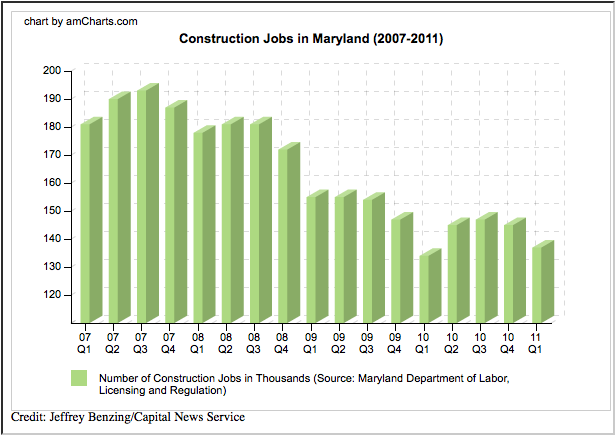WASHINGTON – Federal investment in “shovel-ready” construction put a lot of people to work — and did so quickly — but stimulus money for Maryland work crews is drying up, and some experts say too much of it went to temporary projects that failed to save jobs in the long term.
“I think that’s one of the mistakes of the previous stimulus package — it focused so much on ‘shovel-ready’ projects,” said Anirban Basu, chairman of Sage Policy Group Inc. “The way to get long-term, broadly shared American prosperity is not through road resurfacing.”
Basu, who said the government spends too much overall, but too little on infrastructure, said he thinks jobs legislation that President Obama has pushed since September would also fall short in funding longer-term, transformative projects — things like high-speed rail and overhauls to the country’s air traffic control system.
State officials are considering efforts to fund transportation projects with money from Maryland’s taxpayers. In Annapolis Tuesday, Lt. Gov. Anthony Brown supported the possibility of a 15-cent-per-gallon gasoline tax hike to boost jobs through road and mass transit projects, including construction of the Red Line light rail system in Baltimore and the Purple Line rail system proposed to run between Bethesda and New Carrollton.
This follows a vote in the U.S. Senate Oct. 11 to block Obama’s jobs package, which could have given Maryland $645 million in transportation and construction funds and $315 million more for school repairs, according to the White House. Senate Democrats are still trying to push parts of the bill through.
“The Republicans didn’t even allow us to bring this issue up for debate,” said Sen. Ben Cardin, D-Md. “The president’s proposal, which was heavy on infrastructure, would help an industry that was very much impacted by the downturn in the economy.”
Since early 2009, more than $8 billion in federal recovery money has been funneled through the Maryland economy, including around $650 million in transportation funding, according to state reports.
Basu said this money kept work crews out of unemployment. What it didn’t do was lead to lasting recovery.
Construction is down — shrinking 12 percent in Maryland since Congress passed the American Recovery and Reinvestment Act in February 2009. In early 2011, two years after funds were approved to stop job loss, about 136,000 Marylanders were working in construction, down nearly 25 percent from 2007, according to Maryland’s Department of Labor, Licensing and Regulation.
Your browser does not support iframes.
This has left companies struggling for work and often reluctant to share projects or bid fair deals, a major concern in an industry so dependent on cooperation among subcontractors.
“We can all survive, but we can’t fight,” said Steve Sorrells, operations manager of D&S Site Maintenance and Construction, an Arnold-based company with nine employees. “If I can bite your head off over $1,000 dollars, I’ll bite your head off. But why don’t we just do a job together?”
Sorrells said recovery money was doled out mostly to large general contractors who — because work has been scarce — haven’t done enough to spread it around to smaller companies. Thus the impact for businesses like his has been negligible, he said.
D&S did receive $145,934 in recovery funds as a subcontractor for a Grunley Construction project in Bethesda, according to federal data.
Joe Beuchert of Beuchert Excavating in Newburg said he saw recovery money going mostly to road crews rather than businesses like his that focus on new construction. He called the current state of the industry “horrible” and said the government has focused more on pouring asphalt than building new infrastructure.
Cardin said he thinks some stimulus projects will add jobs, even if transportation money went largely to road and bridge repair.
Maryland pushed these “shovel-ready” projects because they put crews to work quickly, speeding up the timeline for needed repairs.
“If you believe that these projects were going to happen at some point in time, you can argue that you were just accelerating them, and you weren’t really creating anything. You were just sort of kicking the can down the road,” said Joel Zingeser, director of corporate communication at Grunley, which received about $296 million of recovery money in Maryland.
Adie Tomer, a senior research analyst in the Brookings Institution’s Metropolitan Policy Program noted the dueling interests of Congress’ recovery bill.
“They wanted to get the money out fast as well as create jobs,” he said. “They’re not always one in the same.”
Still, recovery funds did allow states to complete repairs that Tomer said needed to be done sooner rather than later. A study by Smart Growth America noted that maintenance jobs were a good use of money because they require little investment in land and materials, and more can be spent on wages.
But public transit projects — things like Red Line and Purple Line — are better long-term investments, Tomer said, because they employ workers over many years and create new kinds of work.
The Red Line is among 14 infrastructure projects fast-tracked Oct. 11 by President Obama for expedited permitting and review.
Spokesman Terry Owens of the Maryland Transit Administration said the project would create around 9,800 construction jobs, citing a study by researchers from the University of Baltimore.
Similarly, the Purple Line could create around 3,000 construction jobs each year over a five-year period, according to a study by Transportation Economics & Management Systems Inc., a Frederick-based consulting firm.
These projects will significantly boost construction, Cardin said, and lead to outside job growth.
The Red Line, estimated to cost about $2.2 billion, and the Purple Line, estimated at $1.9 billion, would both be funded equally with federal and state money, Owens said.
Still, no construction has begun, and the private sector is not rebounding quickly enough to support the industry when federal and state jobs run out.
“Maryland contractors don’t necessarily have the brightest outlook,” said Basu. “I’d expect a couple more soft years, though not necessarily cataclysmic — beyond that, it’s uncertain.”

